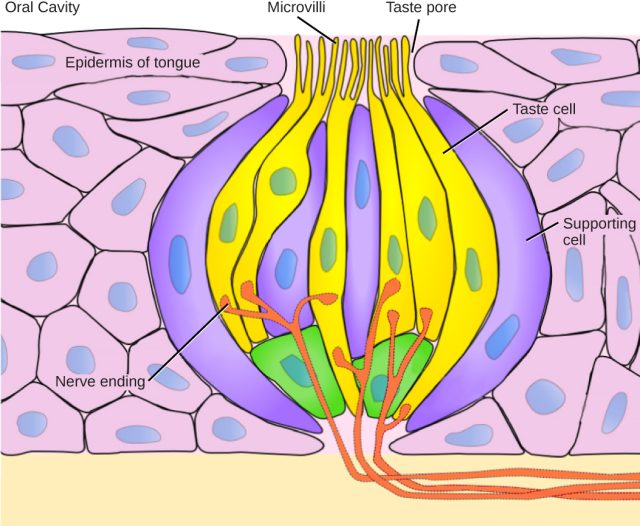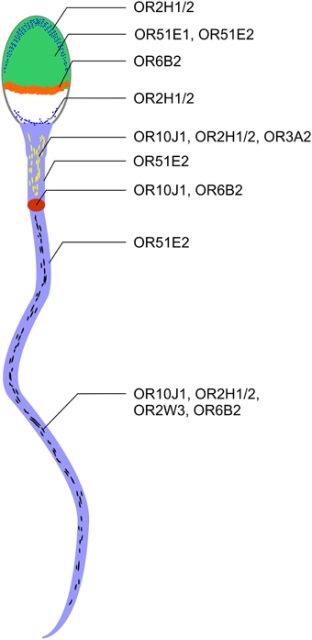Taste receptors: not only in the mouth, not only for taste

The perception of food occurs when food enters the oral cavity and depends on the action of three complementary sensory systems: somesthesia (a group that includes mechanoreception, thermal sensation and nociception), retronasal olfaction and taste. Taste is one of the five classical senses, along with smell, touch, hearing and sight. One of the most common mistakes in primary school textbooks is to indicate that the taste receptors are on the tongue and have a segregated distribution, with one area for sweet, another for sour, etc. This is not the case. The different types of receptors are grouped into papillae, each containing 50 to 150 receptors, their distributions have large overlaps and the papillae are renewed every ten days.
In mammals, taste provides valuable sensory information needed to evaluate the nutritional components of food and to prevent the ingestion of toxic substances and indigestible materials. Taste receptors are sophisticated chemical sensors. Different receptors detect each of the five basic tastes: salty, sour, bitter, sweet and umami. Umami, which means “tasty,” is the least known and is present, among other foods, in tomatoes, ham, seafood, anchovies and aged cheeses. There is evidence of other taste receptors for other components such as long-chain fatty acids, which are abundant in fat. Theoretically, each of the basic taste sensations is recognized by different cells that express specialized receptors and have distinct transduction pathways in the nervous system.

The sense of taste provides essential information about the quality and nature of foods, leading to two specific food responses: consumption or avoidance. Sweet and umami tastes have evolved to recognize a limited number of nutrients. In contrast, the bitter taste, as a defense mechanism, prevents the ingestion of numerous structurally distinct toxic compounds in foods and responds to a high number of bitter substances, but has no need to distinguish which is which or differentiate between them.
The most attractive taste modalities, sweet and umami, are mediated by a small family of three receptors that also combine with each other to form a sweet taste receptor that responds to all classes of sweet tastants, including sugar, artificial sweeteners, D-amino acids, and intensely sweet proteins. If any animal has a homozygous mutation for any of the receptor subunits it shows a drastic loss of sweet taste, something that happens for example to cats, which have a mutation in the T1R2 gene and do not recognize sweet things. It seems that if they like milk it is because of its high fat content.
For centuries we thought that taste receptors were exclusively in the mouth, but in 1996, Dirk Höfer and his group at the University of Würzburg (Germany) found that the protein alpha-gustducin, typical of taste receptors, was also found in brush cells of the stomach and intestine 1. These cells have, like the taste receptors, numerous microvilli which are thought to be the site of chemoreception. The sweet receptor (T1R2 + T1R3) and the umami receptor (T1R1 + T1R3) are found on gastric secretory cells, which induce the release of ghrelin, an appetite-inducing peptide. However, mouth, stomach and intestine are parts of the digestive tract and although no nerve fiber contacts are seen in the brush cells as they do in the taste buds, it is not too strange that cells in the stomach and intestine share proteins with cells present in the mouth. Taste receptors in the digestive system could be related to diet-related diseases such as obesity and other public health problems.
In 2010, things got more complicated. Deshpande and his group discovered bitter taste receptors in a stranger place: lung tissue 2. Some authors have suggested that bacterial metabolites and bitter molecules activate solitary chemosensory cells located in the nose, which act as a warning mechanism against inhaling irritating molecules and microbes. Upon detection of a dangerous substance, the cilia of the respiratory epithelia would beat faster and help to expel these molecules out of the airways. On the other hand, these receptors cause the airways to relax when a bitter substance is encountered. They probably evolved to generate signals to prevent ingestion of plant toxins and help clear lung infections, but they could also be harnessed to treat asthma and chronic obstructive pulmonary disease and perhaps help discover new therapeutic agents with the thousands of known synthetic and natural bitter tastes.
In the following years taste receptors were found in other locations such as the vomeronasal organ, responsible for pheromone perception, and the urinary bladder. In fact, stimulation by artificial sweeteners such as saccharin can enhance smooth muscle contraction in the rat bladder, indicating a possible physiological mechanism. These organs with taste receptors were also joined by the pancreas, liver, brain and testes 34.
The presence of T1R1, T1R2 and T1R3 receptors and their associated G proteins (α-gustducin, Gnb3 and Gγ13) was detected in the mammalian brain, particularly in the hypothalamus, hippocampus and cortex. Interestingly, the expression of taste receptors and taste-related G proteins occurred in both neurons and non-neuronal cells, glia. Thus, it is believed that the T1R2 and T1R3 sweet receptors may function as brain glucosensors. The brain is a major consumer of glucose and its selective use is a useful marker of neuronal activity.
The localization in the testis was the most surprising and caused the most stir. As Chris Simms points out in New Scientist magazine 5, TikTok was filled with people trying to taste things with their private parts, a real hoot, but the subject is scientifically interesting. We can’t distinguish flavors with anything other than our mouths, but taste receptors are all over many other parts of our bodies and understanding their function may lead us to new tools for some of the diseases that afflict us.
And what are the taste receptors in the testicles for? Taste receptors are true chemical sensors, precise, sensitive, specific and useful. They are thought to send signals to the body about sperm and testosterone production. And can they taste food? No. Those influencers who dip their male parts in food or sauces, what they put in contact is only the scrotum, so it will have no effect because that skin is remote and disconnected from the taste receptors of the testicles.

There is another type of chemical receptors which are the olfactory receptors. These molecules, which are conventionally found in the ciliary membranes of olfactory sensory neurons located inside the nose, have recently attracted a lot of attention because of their expression in the spermatozoa of different mammalian species. Spermatogenesis is one of the best characterized stem cell systems and is an example of a development that continues throughout adult life. Men produce sperm every day. The stem cell population undergoes continuous turnover, but the total number of stem cells remains constant. Therefore, there must be a regulatory mechanism that controls the ratio between spermatogonial stem cells that differentiate into spermatozoa and others that maintain the population of cells that maintain the original population. However, this mechanism has yet to be discovered, although it is possible that these chemoreceptors help regulate the process.
The chemoreceptors help the sperm cells to fulfill their function. Millions of these cells, with a unique genetic endowment, must make the long journey to find the egg deep in the female genital tract. To do this, the sperm are endowed with a chemosensory ability to explore their environment and modify their spatial orientation. Chemosignals can influence sperm motility (chemokinesis) and induce chemotaxis and thermotaxis, thus optimizing the interaction between female and male germ cells. Olfactory receptors constitute the largest group of human chemoreceptors and are encoded by about 400 functional genes in the human genome, the largest gene family in our entire DNA. At least 90 olfactory receptor genes are expressed in different sperm compartments, suggesting that they are not only involved in sperm movement but also in other fertilization-related processes such as acrosomal exocytosis, capacitation and spermatogenesis or epididymal maturation 6.
The body is endowed with a large number of taste receptors that act as chemical sensors and inform it of the internal and external world, but the possibilities of chemoreceptors are greater than we think. There are striking examples in insects: taste receptors expressed in the olfactory receptor neurons of the fly are used to detect CO2. This is an important issue because homologues of these receptors are expressed in the CO2-sensing organ of the insect vector of malaria (Anopheles gambiae), and CO2 oozing from our body increases the attraction of mosquitoes to humans. A Drosophila receptor protein called LITE-1 is a light receptor that initiates a phototransduction cascade. Other taste receptors function as temperature receptors for cold and heat. It’s a much more complex and richer world and that’s without it being shown in videos on TIkTok.
References
- Höfer D, Püschel B, Drenckhahn D (1996) Taste receptor-like cells in the rat gut identified by expression of alpha-gustducin. Proc Natl Acad Sci U S A. 93(13): 6631-6634. ↩
- Deshpande DA, Wang WC, McIlmoyle EL, Robinett KS, Schillinger RM, An SS, Sham JS, Liggett SB (2010) Bitter taste receptors on airway smooth muscle bronchodilate by localized calcium signaling and reverse obstruction. Nature Medicine. 16 (11): 1299–1304. ↩
- Li F (2013) Taste perception: from the tongue to the testis. Mol Hum Reprod 19(6): 349-360. ↩
- Montell C (2013) Gustatory receptors: not just for good taste. Curr Biol 23(20): R929-R932. ↩
- Simms C (2024) Why do we have taste buds in our heart and testicles? New Scientist 23 de enero ↩
- Flegel C, Vogel F, Hofreuter A, Schreiner BS, Osthold S, Veitinger S, Becker C, Brockmeyer NH, Muschol M, Wennemuth G, Altmüller J, Hatt H, Gisselmann G (2016) Characterization of the Olfactory Receptors Expressed in Human Spermatozoa. Front Mol Biosci 2: 73. ↩